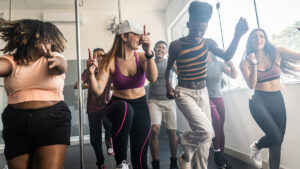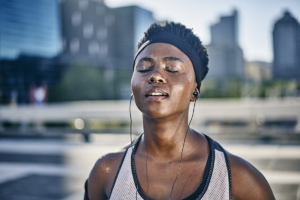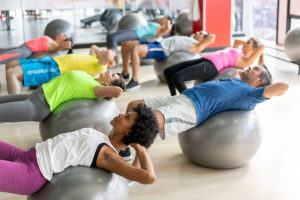Low-Frequency Bass Increases Activity
A new study found that movement increased by up to 11.8% when concert goers heard low-frequency bass music.
Music for Running Performance
On days when mental energy is low, the benefits of music for running can help by lifting performance back to normal levels.
New Music and Exercise Research Findings
New details have emerged on how to use music to enhance training. Tunes with a fast tempo—between 170–190 BPM—are most beneficial for endurance exercise
Fast-Tempo Music Motivates During Exercise
Keep refreshing your up-tempo playlists. Fast-tempo music increases overall exercise tolerance and reduces neuromuscular fatigue, according to a study reported in The Journal of Strength and Conditioning Research (2019; doi:10.1519/JSC.0000000000003417).
Wansink Studies Discredited
Some of the most profound and useful study findings on the psychology and marketing of food and eating published over the past two decades may be invalid. The famed, and now shunned, Cornell researcher Brian Wansink and his Food and Brand Lab published hundreds of studies, many of which have not stood up to scientific scrutiny.
Metabolic Health Versus Weight
Despite more than a decade of intensive efforts to reverse the adult and childhood obesity crises, obesity remains widespread. Generally, the first treatment recommendation is to lose weight, but losing large amounts of weight and keeping it off is difficult, and possibly not even the best reflection of health improvements. After all, the number on a scale is just one measure of health.
Turn Negatives Into Positives
I was a new group fitness instructor taking someone else’s muscle-toning class. “You’re not going low enough,” the instructor yelled at me from across the crowded room. As flames of embarrassment burned my cheeks, I dropped lower into the Romanian dead lift even though I had just come from teaching my seventh cycling class of the week and my body was spent. But this was what the class required, I rationalized, and I was fit—I should be able to keep up.
Unfortunately, I couldn’t keep up, and as a result, I gave myself a nagging lower-back injury.
Music Listening, Meditation and Brain Fitness
Older adults may be able to enhance memory and brain fitness by meditating or listening to music, according to preliminary research findings reported in the Journal of Alzheimer’s Disease (2017; 56 [3], 899–916). West Virginia University researchers in Morgantown, West Virginia, conducted the study to determine whether simple mind-body practices could boost cognition or improve perceived memory loss among older adults with cognitive decline.
9 Ways to Elevate the Group Fitness Experience
Think about all the feel-good experiences that compete with your group fitness classes: a fun night out on the town, quality time with family, a favorite Netflix series cued up after a stressful day at work. It’s no wonder half the beginners who start exercising drop out within the first 6 months (Wilson & Brookfield 2009)!
The Joy of Movement Rings True
There's nothing like post–knee surgery downtime to catch up on my IDEA Fitness Journal reading. The February 2017 issue is just chock‐a‐block full of delectable goodness. In particular, I enjoyed Ryan Halvorson's article "Embracing the Joy of Movement" and Kelly McGonigal's "Ready to Love Your Stress?" Even after 38 years as a fitness pro, I learn something every issue to help me improve as a group fitness leader and baby boomer specialist. Both articles made their points logically, succinctly and persuasively.
Farmhand Fitness Among the Trilliums
Praise for IDEA Personal Trainer Institute™ East
Thank you for the great article “Sample Class: Farmhand Fitness,” by
Ryan Halvorson [Class Take-Out, April 2015]. I have a group of older
adults (mean age 70) who train outdoors near Montreal, doing boot
camp–style classes in summer and snowshoeing in winter.
Music Keeps Cardiac Patients Moving
Walk into most fitness facilities and you’ll likely hear some sort of music playing. Could that music be what motivates people to move more? For a group of cardiac rehabilitation patients, that was indeed the case.
How To Be A Sound Friend
As a group fitness instructor, you are the first line of defense when it comes to sound safety. Excessive noise can not only drive away customers but can also damage the ear drum.
Use the following tips to make sure you and your fitness facility are staying within safe sound-level parameters.
Are You a Sound Friend or a Sound Foe?
How loud is too loud? The sound of a power lawn mower registers about 90 decibels, and a chainsaw about 110 (CDC 2013). What are the sound levels in your classes? Workouts may help participants feel motivated to improve their strength and endurance, but blasting music can lead to hearing loss.
Finding New Tunes And Musical Picks
What’s the best way to discover new, exciting tracks? Here’s some advice from our experts, followed by sample playlists:
Science Uncovers the Perfect Playlist
Thirty years ago, Fred Hoffman, MEd, 2007 IDEA Fitness Instructor of the Year, taught with a light heart and a heavy bag of vinyl records. “I brought a stack of albums with me to class,” he recalls. “I changed the music after each song, [switching] the LP each time. There was no such thing as mixed music!”
Australian Music Tariff Update
In May 2010, the Australian Copyright Tribunal voted for a significant fee hike (from $0.98 AUS to $15 AUS per class) for fitness facilities that play music in group exercise sessions. The Phonographic Performance Company of Australia (PPCA), an organization that protects sound recordings and music videos, requested the increase. Later that year the appeal courts overturned the ruling, prompting the PPCA to file its own appeal, which was rejected.
Music Aids Performance
Want your clients and athletes to reach new levels of power performance? Have them train while playing their favorite tunes. A study published in the Journal of Strength & Conditioning Research (2011; doi: 10.15191JSC.obo13e318237e7b3) suggests that athletic performance improves when a client gets to choose his own music. The study involved 20 trained college males who performed three bench-press sets to failure at 75% of 1-repetition maximum (1-RM) and three jump squats at 30% of 1-RM.
The Soothing Power of Music
In the April issue of IDEA Fitness Journal, you asked if anyone was using music to enhance the experience of clients. I am a clinical musician intern playing harp for patients in the hospital as well as in hospice care. I include harp playing to induce the relaxation response during my yoga classes. I use the musical scale to tone the body to get ready for exercise and then use harp music at the end for relaxation, meditation and visual imagery.
















